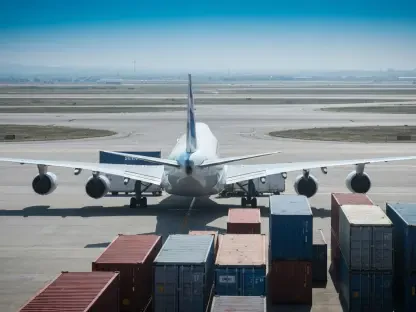The logistics and supply chain sector is facing a mounting crisis as cargo theft becomes increasingly sophisticated and prevalent amid fluctuating economic conditions. This growing issue is affecting the industry more than ever before, necessitating a closer look at how logistics leaders are addressing this surge. In this article, we explore the intricacies of cargo theft, the technological methods employed by criminals, and the collaborative efforts being made to mitigate this pervasive threat.
Quantifying the Rise in Cargo Theft
The alarming rise in cargo theft has been quantified with reports indicating a 59% increase in incidents between Q3/Q4 2022 and 2023. A combination of economic downturns and advancements in technology has created a fertile environment for thieves. High-value electronics, along with food and beverage commodities, have been particularly affected, driven by their high market value and the ease with which they can be resold.
Janelle Griffith, a logistics expert from Marsh Specialty, explains that the cyclical nature of the supply chain contributes to these theft trends. When one sector experiences fluctuations, it impacts the entire supply chain, creating opportunities for thieves who are acutely aware of market demands. Their ability to quickly adapt their focus to items with high resale potential exacerbates the challenges faced by logistics leaders, underscoring the need for more dynamic protection measures.
In an environment ripe for exploitation, logistics companies must be more vigilant than ever. The high-stakes environment is complicated further by the fast pace at which stolen goods can be unloaded and converted into cash. This rapid turnover adds pressure on those responsible for securing shipments, pushing them to develop more advanced and foolproof security measures. These efforts must be both reactive to current trends and proactive in anticipating future tactics employed by increasingly savvy criminals.
Technological Sophistication in Theft Operations
Thieves operating in today’s landscape have evolved significantly, employing cutting-edge technology to carry out sophisticated heists. Unlike the traditional smash-and-grab tactics, modern criminals use advanced methods such as hacking into logistics systems to alter vital shipping documents. One particularly effective tactic involves manipulating bills of lading and using fraudulent pickups to execute thefts.
By falsifying legal documents and impersonating legitimate companies, thieves can reroute shipments seamlessly, avoiding physical confrontations and brute force altogether. This technological leap has essentially redefined the landscape of cargo theft, turning it into a sophisticated cybercrime arena that challenges even the most advanced security systems. The implications of this shift are profound, necessitating a reevaluation of how technology is used, both defensively and offensively.
As technology continues to advance, so too do the methods of those who seek to exploit it. This creates a cat-and-mouse dynamic where logistics companies must constantly upgrade and adapt their security measures. The increasing complexity and seamless execution of cyber manipulations highlight the necessity for comprehensive cybersecurity strategies. These strategies need to incorporate multiple layers of defense, from encryption and secure communication protocols to continuous monitoring and rapid response capabilities.
Preventative Measures and Collaborative Efforts
To effectively combat the rising tide of cargo theft, a concerted effort across the entire supply chain is imperative. Rail companies, shippers, intermediaries, and law enforcement agencies must collaborate to fortify security measures. These efforts include the establishment of dedicated FBI task forces, which focus exclusively on cargo theft, as well as increased patrolling along high-risk routes. These initiatives are designed to foster a more secure environment and safeguard shipments from opportunistic thieves.
These collaborative endeavors have shown promising results, particularly in dismantling organized theft rings. However, the adaptable nature of these criminal groups means that vigilance must be continuous, with strategies evolving to counteract new tactics. Innovation in security measures is key to maintaining the upper hand. Stakeholders are increasingly turning to technology not only for immediate solutions but also for predictive analytics that can identify and mitigate threats before they materialize.
Collaboration extends beyond immediate security measures. It involves the sharing of information and intelligence across the supply chain to create a unified front against cargo theft. This collaborative approach ensures that vulnerabilities are identified and addressed promptly and that successful strategies are disseminated across industry lines. By working together, stakeholders can create a more resilient and robust logistics network that is less susceptible to disruptions caused by theft.
Insurance Challenges and Risk Mitigation
The significant surge in cargo theft has had a noticeable impact on the insurance sector, creating a climate of higher premiums and stricter underwriting guidelines. Insurers are now demanding more comprehensive safety and security protocols from logistics entities to mitigate the heightened risks associated with cargo theft. These requirements include mandates for shippers to avoid making unattended stops and for freight brokers to ensure that their truckers maintain control over cargo throughout the transportation process.
While these measures are critical for risk mitigation, they come with increased operational costs. The financial burden of implementing stringent security protocols, coupled with higher insurance premiums, ultimately gets passed down the supply chain and impacts consumers. Logistics companies operating on tight margins find themselves squeezed further, their profitability tied directly to their ability to prevent thefts and meet insurance requirements.
Mitigating these risks also requires a cultural shift within organizations, prioritizing security at all levels. This involves regular training for employees, the adoption of advanced security technologies, and a commitment to continuous improvement in security protocols. By fostering a security-first mindset, companies can better navigate the challenges posed by cargo theft, ensuring that their operations remain both efficient and secure.
The Role of Specialized Security Companies
Specialized security firms have become crucial players in the fight against cargo theft. Often founded and staffed by individuals with backgrounds in law enforcement, these companies have the expertise and experience to implement effective security measures, particularly in high-theft regions such as California, Florida, Texas, and Illinois. Their targeted interventions have led to significant reductions in theft incidents in some areas, showcasing the value of specialized strategies.
However, the migratory nature of theft rings poses a continual challenge. When pressure is applied in one region, these criminal activities often shift to another, necessitating a national or even global approach to cargo theft prevention and monitoring. This underscores the importance of coordination and information sharing across regions and borders, enabling a more comprehensive and unified response to cargo theft wherever it occurs.
These firms also offer tailored solutions, utilizing advanced technology, real-time monitoring, and rapid response teams to protect shipments. Their interventions are not just reactive but also preventive, identifying potential threats before they can materialize. This proactive approach is essential in creating a secure logistics environment that can withstand the evolving tactics of sophisticated criminals.
Building a More Secure Supply Chain
According to Janelle Griffith, the key to building a secure supply chain lies in leveraging technology effectively. Many logistics companies have already integrated advanced security systems, rigorous training protocols, and robust partnerships with law enforcement into their operations. However, there remains a critical need for greater transparency and information sharing within the supply chain.
Griffith envisions a transition from a fragmented supply chain to a seamless supply line, characterized by uninterrupted information flow and collective action. This paradigm shift is essential in eliminating vulnerabilities that thieves can exploit. Greater transparency and collaboration among all stakeholders will ensure that security measures are uniformly applied and that any potential weak points are promptly addressed.
Technology plays a vital role in this vision. By adopting cutting-edge security measures and predictive analytics, logistics companies can anticipate and mitigate risks more effectively. Enhanced visibility and real-time tracking of shipments allow for quicker responses to potential threats, while robust communication channels facilitate the sharing of critical information. This integrated approach is essential in creating a resilient and secure supply line that can withstand the challenges posed by cargo theft.
Broader Implications for the Supply Chain and Public
The logistics and supply chain industry is grappling with a serious issue as cargo theft becomes more advanced and widespread, especially in today’s fluctuating economic environment. This escalating problem is putting more pressure on the industry than ever before, making it essential for logistics leaders to take a closer look at how they can combat this surge in theft. Cargo theft is not a new problem, but its sophistication and frequency have grown alarmingly. Thieves are leveraging advanced technology to outsmart traditional security measures, using tools like GPS jamming devices to track and intercept valuable shipments.
The economic uncertainty has only exacerbated this issue, making high-value, easily movable goods even more tempting targets. To address this, companies are innovating their security measures and collaborating more closely with law enforcement agencies and other stakeholders in the supply chain. By sharing information and developing new technologies, they aim to stay one step ahead of the criminals. This article examines these strategies and the importance of industry-wide cooperation in curbing cargo theft, which continues to pose a significant threat to the efficiency and reliability of global supply chains.









